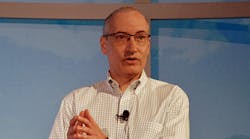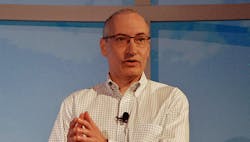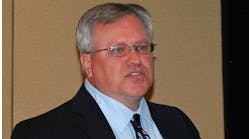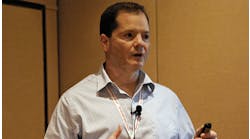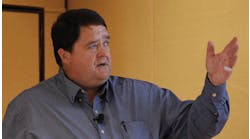“Green hydrogen is exciting because it comes from the electrolysis of water using renewable power.” Honeywell UOP’s Andrea Bozzano is bullish on the company’s expertise in membranes and catalysis to improve the economic competitiveness of green hydrogen as an alternative, zero-carbon fuel.
Andrea Bozzano, senior director of R&D Honeywell UOP, was among the subject matter experts welcomed to the Honeywell Users Group Americas 2022 keynote stage by Jason Urso, vice president and CTO, Honeywell Process Solutions. Bozzano’s role was to discuss what sustainable means for the larger Honeywell organization, and the several pathways to greenhouse gas emissions reduction the company is developing, including the fuel transition, carbon capture technology, and the real-time monitoring of emissions—including fugitive ones.
Honeywell has already been tackling the fuel transition to renewable sources, with its Ecofining technologies for the production of renewable diesel fuel. “The molecules that define these fuels are identical to the types of molecules that are defined and controlled from their petroleum counterparts,” Bozzano said. “You can blend those products seamlessly into fuels.” The process can also use a wide range of feedstocks: plant oils, animal fats, algae oils and cooking oils. “Most importantly, the carbon footprint of the fuels produced in this way is significantly lower than the carbon footprint of their petroleum counterparts,” Bozzano said.
Ecofining clean hydrogen
One of Honeywell’s newest innovations in renewable fuels is the integration of clean hydrogen with this Ecofining technology. “So, we can take some of the byproducts for Ecofining and use them as feedstock to the steam methane reformer to make clean hydrogen,” Bozzano said. Combined with carbon capture technology, this can reduce the carbon footprint of these fuels up to 90% lower, compared to petroleum alternatives.
By 2050, more than 60% of the jet fuel produced in Europe is expected to come from renewable resources. “So the question is, how do we get there?” Bozzano asked. For more than a decade, Honeywell has offered technology solutions for producing renewable diesel, as well as sustainable aviation fuel (SAF). “Used cooking oil isn’t going to get us there; there just isn’t enough,” Bozzano said.
One of the major new feedstocks that Honeywell is considering is biomass conversion, through a partnership with Alder Fuels to develop this renewable fuel. “We expect to commercialize the technology within the next few years,” Bozzano said. He also announced that United Airlines has signed a takeoff agreement for up to 1.5 billion gallons of the new fuel over the next 20 years.
Hydrogen blending is another important pathway to sustainability. In the refinery space, the majority of hydrogen is produced through a process called steam methane reforming or autothermal reforming, using natural gas to produce hydrogen, Bozzano said. “It comes with a pretty significant carbon footprint,” he added. The next steps will be the production of alternative blue and green hydrogen. Blue hydrogen technology is available now, Bozzano said. It involves producing hydrogen through traditional means but adding carbon capture.
“Green hydrogen is exciting because it comes from the electrolysis of water using renewable power,” Bozzano said. The technology exists today, but it is not yet cost effective, he added. Honeywell is working to make significant improvements in the efficiency and cost of electrolysis, using its expertise on membranes, catalysis and material science and chemistry. “We are expecting to commercialize the technology very soon,” Bozzano said.
Easing hydrogen transport
One of the challenges with hydrogen relates to geography: where it’s produced isn’t necessarily where it’s needed. Transportation will be a major factor to its widespread use. One option is an LOHC, or liquid organic hydrogen carrier. “We can take the hydrogen produced in one region and tie it up with an organic molecule,” Bozzano said. It can then be transported as a liquid, similar to the means for traditional petroleum, then liberated at its destination. The technology is there but needs the market to develop, Bozzano added.
Once the hydrogen makes it where it’s going, one option is to combust it, often blended with traditional natural gas. The company’s latest burners, Urso explained, can accommodate such blends up to and including 100% hydrogen. “What this means is when you buy a burner today, you’re buying a future; your future-proofing your operation.”
Hydrogen can also be injected into a gas distribution grid, Urso added. “We’ve deployed over 200 gas skids to deploy biofuels or hydrogen into gas distribution networks,” he added.
Another pathway for reducing carbon emissions is carbon capture, which affects a broader array of different industries, Urso said. Honeywell will introduce a technology this year to capture carbon from industries including steel, cement, coal and power. “We have developed and are introducing a device called ASCC, advanced solvent carbon capture,” Bozzano said. This technology can capture as much as 90% of the carbon dioxide from these sources.
Hunting down fugitive emissions
Monitoring and reporting are also an important part of carbon reduction, Urso said. Many companies calculate emissions levels on a periodic basis based on gas composition and burner efficiency, as required by regulatory requirements. “But they often do the same when it comes to estimating leaks of greenhouse gases,” Urso said.
Leak detection and remediation is largely a manual, labor intensive operation. For real-time monitoring of fugitive emissions leaks across a site, Honeywell is introducing the Experion Fugitive Emissions Monitoring system. Two new sensors will collect leakage data in real-time. The swarm sensor is battery-powered and can be deployed wirelessly. “They’re called a swarm sensor because we’re going to swarm a production area with the sensors,” Urso said. It also identifies factors like wind direction, in order to triangulate the location and characteristics of a combustibles leak.
The other new product for leak detection is the Rebellion camera with hyperspectral imaging technology, which can monitor precisely where a leak is located and the extent of any associated plume. These sensors connect directly to the control system where standard displays can show a site-wide view. With a physical rendition of the site, the system can plot where the sensors are and where the actual leaks are located. The system can also zoom in to show a heat map indication of the relative size of the leaks on the site and provide a search area for more precise testing. Honeywell is running some pilot projects over the summer, and the technology will be available later this year.
The editors of Control, Control Design and Smart Industry are reporting live from 2022 Honeywell Users Group in Orlando, Florida, to bring you the latest news and insights from the event. When the event comes to a close, the best, most important coverage will be compiled into a report by the editors.
Register now to pre-order the report and be among the first to receive it in your inbox.
